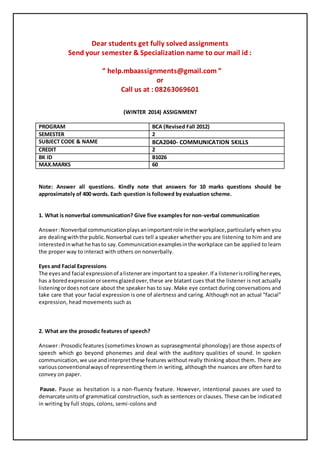
Bca2040 communication skills
- 1. Dear students get fully solved assignments Send your semester & Specialization name to our mail id : “ help.mbaassignments@gmail.com ” or Call us at : 08263069601 (WINTER 2014) ASSIGNMENT PROGRAM BCA (Revised Fall 2012) SEMESTER 2 SUBJECT CODE & NAME BCA2040- COMMUNICATION SKILLS CREDIT 2 BK ID B1026 MAX.MARKS 60 Note: Answer all questions. Kindly note that answers for 10 marks questions should be approximately of 400 words. Each question is followed by evaluation scheme. 1. What is nonverbal communication? Give five examples for non-verbal communication Answer:Nonverbal communicationplaysanimportantrole inthe workplace,particularly when you are dealingwiththe public.Nonverbal cues tell a speaker whether you are listening to him and are interestedinwhathe hasto say.Communicationexamplesinthe workplace can be applied to learn the proper way to interact with others on nonverbally. Eyes and Facial Expressions The eyesand facial expressionof alistenerare important toa speaker.If a listenerisrollinghereyes, has a boredexpressionorseemsglazedover,these are blatant cues that the listener is not actually listeningordoesnotcare about the speaker has to say. Make eye contact during conversations and take care that your facial expression is one of alertness and caring. Although not an actual "facial" expression, head movements such as 2. What are the prosodic features of speech? Answer:Prosodicfeatures (sometimes known as suprasegmental phonology) are those aspects of speech which go beyond phonemes and deal with the auditory qualities of sound. In spoken communication,we use andinterpretthese features without really thinking about them. There are variousconventionalwaysof representing them in writing, although the nuances are often hard to convey on paper. Pause. Pause as hesitation is a non-fluency feature. However, intentional pauses are used to demarcate unitsof grammatical construction, such as sentences or clauses. These can be indicated in writing by full stops, colons, semi-colons and
- 2. 3. Define hearing and Listening. How is ‘hearing’ different from ‘listening’ Answer : Hearing is one of the five senses of a person and it is the ability to perceive sound by detectingvibrationsthroughan organ such as the ear. Listening also known as ‘active listening’ is a technique used in communication which requires a person to pay attention to the speaker and provide feedback.Listeningisastep further than hearing, where after the brain receives the nerve impulses and deciphers it, it then sends feedback. Hearing and Listening, though synonymous, are complete different things. You can listen to someone without actually hearing anything. Dear students get fully solved assignments Send your semester & Specialization name to our mail id : “ help.mbaassignments@gmail.com ” or Call us at : 08263069601
